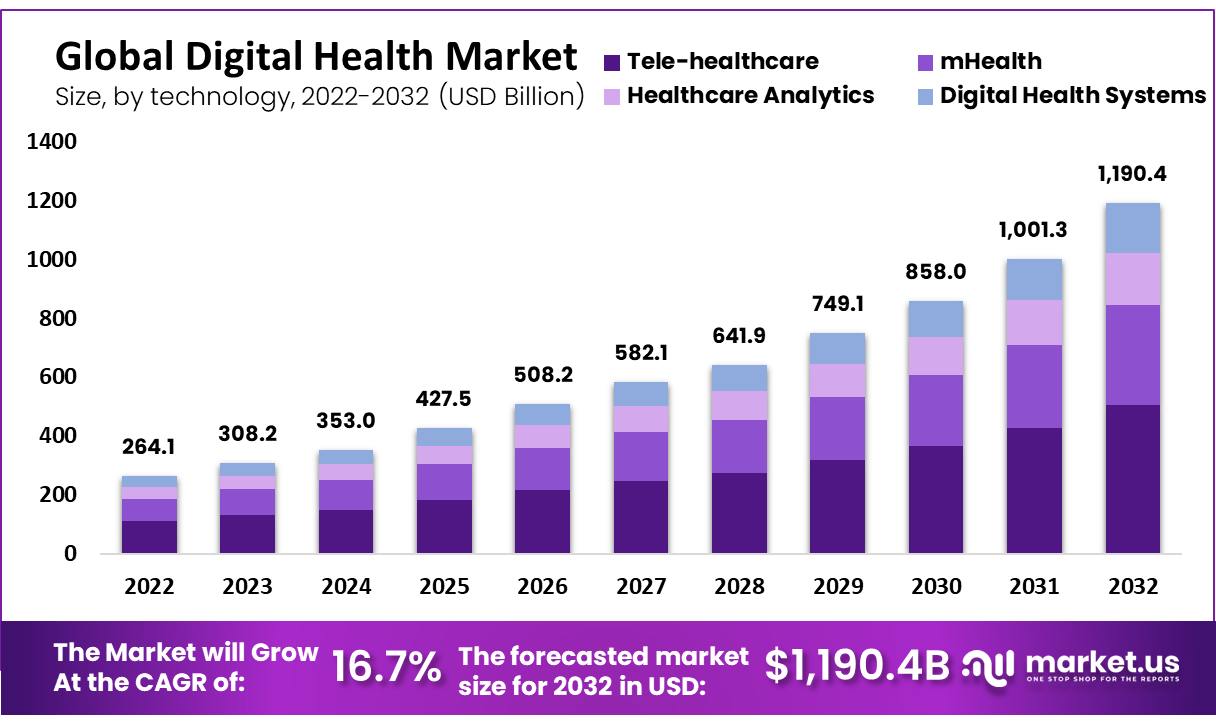According to Medical Technology and Innovation Statistics, In recent years, there has been a remarkable acceleration in the pace of medical technology and innovation advancements, driven by factors such as technological advancements, increased funding for research and development, and the growing demand for innovative solutions to address healthcare challenges.
These advancements have the potential to revolutionize various aspects of healthcare delivery, from diagnostics and treatment to patient monitoring and disease prevention.
Table of Contents
Editor’s Choice
- The global medical technology and innovation market was valued at $456.9 billion in 2020 and is projected to reach $695.5 billion by 2027, growing at a compound annual growth rate (CAGR) of 6.1% during the forecast period.
- The adoption of telemedicine services increased significantly during the COVID-19 pandemic. In the United States, telehealth visits accounted for approximately 20% of all healthcare encounters in April 2020, compared to less than 0.01% before the pandemic.
- In 2022, the Global Generative AI in Healthcare Market was valued at USD 0.8 billion and is expected to be valued at USD 17.2 billion in 2032. Between 2023 and 2032, this market is estimated to register the highest CAGR of 37.0%.
- Wearable devices for healthcare applications are rapidly growing. The Global Wearable Medical Devices Market size is expected to be worth around USD 156.0 Billion by 2032 from USD 34.9 Billion in 2022, growing at a CAGR of 16.60% during the forecast period from 2023 to 2032.
Digital Health Adoption and Telemedicine: Key Statistics and Market Projections
Adoption of Digital Health
- The global Digital Health Market size is expected to be worth around USD 1,190.4 Billion by 2032 from USD 264.1 Billion in 2023, growing at a CAGR of 16.7% during the forecast period from 2023 to 2032.
- The US showed a 154% increase in telehealth usage in the first quarter of the year 2020.
- 76% of people over the age of 55 have used telemedicine.
- In the 2022 Survey, 80% of all respondents reported having accessed care via telemedicine at some point in their lives, up 8pp from 72% in 2021.
- 23.4 million U.S. patients will utilize remote patient monitoring services and tools in 2022.
- By 2024, remote patient monitoring services and tools are expected to reach 30 million U.S. patients.
- 80% of Americans favor remote patient monitoring and more than one-half are strongly supportive of incorporating it into medical care services.

Adoption of Telemedicine
- The global telemedicine market size is expected to be worth around USD 590.9 Bn by 2032 from USD 63.5 Bn in 2022, growing at a CAGR of 25.7% during the forecast period from 2022 to 2032.
- The US showed a 154% increase in telehealth usage in the first quarter of the year 2020.
- About 2,720 million participants rated telemedicine in the COVID-19 pandemic.
- 70% of medical professionals rated telemedicine in the COVID-19 pandemic.
- Asia Pacific region showed a 52% increase in telehealth access to primary physicians/general patient services from 4% to 56%.
- Telehealth visits increased by 154% in the U.S. during the last week of March 2020 compared to the same period in 2019.
- The percentage of telehealth visits among Medicare primary care visits increased from 0.1% in February 2020 to 43.5% in April 2020.
- In a survey, 56% of physicians in the U.S. reported using telemedicine to provide care during the pandemic, compared to 18% before the outbreak.
- In a study, 76% of patients expressed interest in using telehealth to replace in-person visits, and 59% had a favorable impression of telehealth.
- The number of telehealth visits is projected to reach 1 billion by the end of 2020, with around 900 million visits attributed to the COVID-19 pandemic.
Artificial Intelligence (AI) in Healthcare With Medical Technology and Innovation
- According to market.us, the global artificial intelligence in the healthcare market was valued at USD 9.81 billion in 2022. It is projected to reach USD 238.5 billion at a CAGR of 38.73% between 2023 to 2032.
- About 45% of healthcare services worldwide adopted data integration software for their organizations.
- 36% of organizations implemented natural language processing software.
- North America is dominant in global AI in the healthcare market with the largest market share of 59.1%.
- By 2030, annual healthcare spending in the United States is expected to reach $6.8 trillion.
- The government share of this spending is projected to be 48% by 2030, driven by increases in Medicare enrolment, as more than 10,000 Americans become eligible for Medicare each day.
- 1.8% of organizations in the United States use machine learning in healthcare services.
- 1.3% of healthcare organizations use natural-language processing.
- In 2022, 12.6% of workers were employed at firms that utilize AI in healthcare.
- 51% of US adults who say ethnic biases in healthcare are a problem believe AI will reduce bias.
- According to market.us, the global artificial intelligence in drug discovery market was valued at USD 1.2 Billion in 2022. Between 2023 and 2032, this market is estimated to register the highest CAGR of 27.5%. It is expected to reach USD 12.8 Billion by 2032.
Robotics and Automation in Healthcare
- Robotic surgeries have increased to 15% of total surgical procedures despite limited evidence supporting them.
- The global market for robotic surgery systems was valued at $4.45 billion in 2020 and is projected to reach $11.45 billion by 2028, growing at a CAGR of 12.3% from 2021 to 2028.
- Intuitive Surgical’s da Vinci Surgical System is the world’s most-utilized robotic surgical system with over 5,000 installations worldwide.
- Robotic surgery is most extensively used in urology, with prostatectomy being one of the most common procedures performed using robotic surgery.
- Studies comparing robotic-assisted surgery and open surgery for colorectal cancer treatment found that patients undergoing robotic-assisted surgery experienced significantly fewer complications (14.1% vs 21.2%) and shorter hospital stays (6.7 vs 8.4 days).
- In 2022, the global surgical robotics market was valued at around USD 65 billion. By 2030, the market size was forecast to increase to nearly USD 119.7 billion.
Biotechnology Innovations
- The number of approved gene therapies has been steadily increasing. As of September 2021, the U.S. Food and Drug Administration (FDA) has approved over 20 gene therapies for various diseases, including inherited disorders and certain types of cancer.
- The biotechnology industry is a major driver of job creation and economic growth. In the United States, the biotechnology sector employs over 1.8 million people, and in 2019, the industry contributed $1.3 trillion to the country’s economic output.
- The global biopharmaceuticals market size is expected to be worth around USD 566 billion by 2032 from USD 263 billion in 2022, growing at a CAGR of 8.2% during the forecast period from 2022 to 2032.
- The global gene therapy market size is expected to be worth around USD 49.3 Bn by 2032 from USD 5.6 Bn in 2022, growing at a CAGR of 25% during the forecast period from 2022 to 2032.
- Ethics and policy in CRISPR have gained significant traction with more than 50 countries across the globe implementing guidelines and regulations to address ethical concerns.
Discuss your needs with our analyst
Please share your requirements with more details so our analyst can check if they can solve your problem(s)



